ACE Students Demo Their Hybrid Vigor at UCI
|
June 24, 2004 -- The Arts Computation Engineering (ACE) graduate program wrapped up its first year of existence at UC Irvine with 'hybrid vigor.' The first nine graduate students admitted to the pioneering program organized an open lab exhibition showcasing their own work and selected new media and interdisciplinary art and technology initiatives across campus.
ACE, an interdisciplinary program in arts, engineering, and information and computer sciences, is oriented toward originators of novel techno-cultural formations, makers of machines, environments and non-standard technological systems.
"The combination of these fields will produce a new kind of professional ideally equipped to innovate and to provide leadership in emerging techno-culture," said Simon Penny, director of ACE and Calit2 Irvine division new media arts layer researcher.
While digital imaging and computer graphics are seen as key areas, the ACE program does not focus on the production of works whose final from is non-interactive linear image streams, such as films or video. Nor is cultural practice oriented towards sedentary desktop interaction a central focus of the program. Real time computation, robotics and motion control, sensor technologies, immersive media technologies, computer graphics, embedded and wireless technologies are key technical areas. Computational techniques which focus upon emergent and generative real time performance are emphasized.
The open lab exhibition called "Hybrid Vigor" was held at UCI's Beall Center for Art and Technology and featured experimental new media art projects.Among the works demonstrated:
| Dance DJ Revolution by Eric Cho This project features a simulated dance club environment that allows patrons to challenge the authority of the disc jockey. It appropriates aesthetics of the popular “Dance Dance Revolution” arcade game to create an interactive system that will be used to allow music listeners to alter their listening experience while in a dance club setting. The project attempts to take the traditional notions and exclusivity attached to being a DJ and place them in the hands of regular event patrons. |
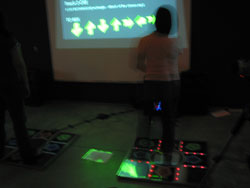 |
| Channel Zero, vol. 1: Aggravision by Sky Frostenson This project culls the majority of its content from a video database collection harvested from peer-to-peer filesharing networks, where the most salient and sensational clips inevitably rise to the top of the download queue.. Through Channel Zero’s joystick, steering wheel and pedal interface, the participant is invited to mix, explore and sometimes avoid material that ranges from the simply inane to the nauseatingly macabre. No matter what the individual subject or effect, the images in the collection ultimately blend to represent a small cross section of the tastes, trends and fixations that drive these unregulated and decentralized media networks. |
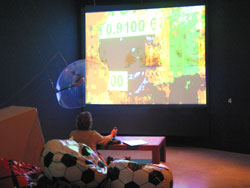 |
|
Infinicity by Adrian Herbez |
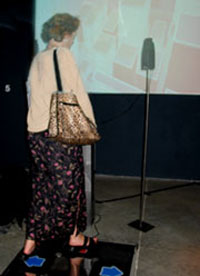 |
|
Experiments in Galvanism: Frog with Implanted Webserver by Garnet Hertz |
 |
| Autonomous Radiobodies: radiophonic graffiti disruptions of localized receivers by Ryan Schoelerman This project is a pubic art performance/installation that involves people wearing or carrying units equipped with a radio graffiti device (RGD) for creating localized radiophonic art spaces. The intent is to create an immediate public voice space for listeners by using the mainstream FM broadcast as a background and disrupting it on a localized level with spontaneous short radio burst interruptions. The RGD is a compact combination of a PLL-tuned FM transmitter and vocal sampling unit. The RGD user listens to a selected commercial radio station via a portable FM radio and then ‘tags’ the broadcast of that selected station with his/her own voice and subsequently interrupts the broadcast reception of any receivers within a range of a couple hundred meters. |
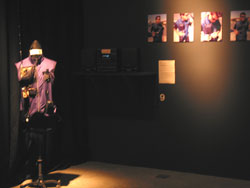 |
| Perception by Margaret Watson Perception is a first stage exploration of embodied interaction consisting of a real-time system driven by an ultrasonic ranging sensor. The sensor can detect the presence of visitors as they interact with video and sound through re-positioning themselves in the physical installation space. The concept of the project is to use the body as an interface to navigate through visual, aural and physical space. Specifically, the intent is to allow visitors to become aware of their bodies as a significant and natural component in interacting with a computational system. |
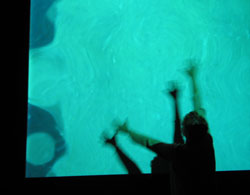 |

